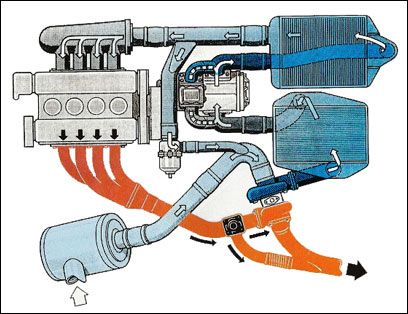Technical Curiosities: Twincharging

Twincharging: Combining turbocharging and supercharging on the same engine. Blending of the low-rpm immediacy of a supercharger’s response with the high-end power and efficiency of a turbocharger.
Only a few automakers have attempted such a complex hybrid system in a production automobile. Continuing with the Lancia theme started with yesterday’s post, the Italian automaker was the first to offer a vehicle featuring twincharging for sale with the homologation version of their all-conquering Delta S4 Group B rally monster. The S4 Stradale, as it was called, was fitted with a detuned but otherwise intact version of the full-blown rally car’s mid-engined turbo- and supercharged 1.8l DOHC 4-cylinder. Downrated to “only” 250 hp for the Stradale, the powerplant was capable of cranking out upwards of 500 hp in race trim, and what’s more, able to deliver that power in a right-now, linear fashion ideal for low-grip rally competition.

As far as the mode of operation, there are a couple of way of doing it: Turbo first, or blower first. Lancia opted for the former, positioning the supercharger closest to the engine for immediate response, and incorporating a valve to allow the turbo to bypass the blower when up to speed and pressurize the intake charge with less restriction. The cost was obviously the complexity of the additional plumbing, drive belt, second intercooler and the like, but the system avoided the wasteful, manifold-destroying characteristics of contemporary anti-turbo-lag setups, which essentially dumped raw fuel immediately upstream of the turbine inlet in order to keep the turbo spooled between shifts.
More recently, Volkswagen has introduced a supercharger-first twincharging system on their 1.4TSI engine. Slightly less complex and more production-oriented than Lancia’s racing-focused effort, VW’s engine uses the blower’s output not only to boost the engine, but also to keep the turbo spooled at low rpm. For further reading on the 1.4TSI, check out this excellent Autozine article.
Editor’s note: This post is part of an ongoing series spotlighting obscure automotive engineering solutions. Read the other installments here:

Somehow Jaguar has proposed using a 1.5 liter engine able to develop 500 boosted horsepower momentarily and recharge their hybrid’s battery at slack times. Sounds optimistic to me. I find the engine compartments of the twin turbo setups to be unsightly and the difficulty in rejecting waste heat seems like a dissuasion to using them.
IS IT POSSIBLE TO TAKE A MCE-5 VCRI ENGINE & A DOHC IVTEC ENGINE & PUT TWIN TURBOS FEEDING A SUPERCHARGER INTO A V4 ENGINE OR A INLINE 4 CYLINDER, AND GET HORSEPOWER AS WELL AS GREAT GASMILEAGE ? A HONDA CRX HF SERIES BACK IN THE 80’S WAS ABLE TO GET 49 MPG IN CITY & 60 MPG HWY. WHY NOT MAKE A 8 SPEED THAT COULD DOUBLE THAT ? THE GEARS IN THE CRX IS : 1ST 2.92 2ND 2.03 3RD 1.44 4TH 0.89 5TH 0.65 FINAL DRIVE 3.58 . A 2006 YAMAHA R6 ENGINE REVVED TO 18,000 RPMS , IS IT POSSIBLE TO GET A CAR ENGINE TO REV LIKE THIS WITH THE VCRI ENGINE WITH THE DOHC I-VTEC CONCEPT WITH THE 2 TURBOS & SUPERCHARGER AS WELL.
I’d love to try to answer your question but the shouting is too much. Please try again without using the Caps Lock key.
I’d be curious to see if ecomotors’ electric turbocharger would fit this bill: it has an electric motor/generator that can spool up the turbo while exhaust gases are low, thus eliminating lag, and then can use excess exhaust pressure to generate power, so you’d only need a blowoff valve as an emergency last resort.
Likewise; I’ll have to look into that. Most people aren’t aware of the amount of horsepower a turbocharger absorbs from the engine. The equivalent electric motor’s output would have to be in the dozens of HP (and thus massive) in order to approach the same effect. Just spooling the turbo in a no-load situation might take less, however, and be feasible.